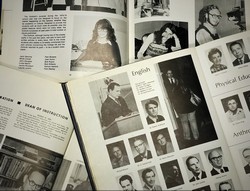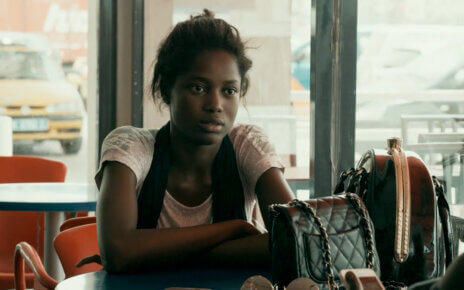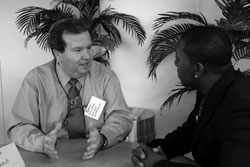Racist Yearbook Photos Resurface, University Responds
 University President Grey Dimenna, Esq., condemned the existence of 13 individual offensive photographs in yearbooks going back from the 1960s to the 1980s in an email statement to the entire campus community on Feb. 27.
University President Grey Dimenna, Esq., condemned the existence of 13 individual offensive photographs in yearbooks going back from the 1960s to the 1980s in an email statement to the entire campus community on Feb. 27.
The statement revealed that ten pictures depicted individuals posing in blackface, a form of make-up used by people not of color to represent the depiction of an African American person. The other three pictures were said by Dimenna to be offensive to other religious and cultural groups.
“None of the images identify the individuals by name, and in some cases even the context is missing because the pictures are not associated with a specific campus event or activity,” Dimenna said in his statement. “What is unmistakable is that these pictures are offensive and do not reflect the values of Monmouth University today.”
Dimenna said the offensive images were found after ordering an examination of all the University’s past yearbooks, in light of the controversy surrounding Virginia Governor Ralph Northam being associated with racist images and names in his medical school yearbook.
When asked his first reaction upon finding the images, Dimenna said, “I was surprised and disappointed that such offensive pictures would be part of Monmouth’s tradition. I also immediately thought of how we could turn this hurtful situation into a learning experience as the images warranted acknowledgment, transparency, and action.”
According to National Public Radio, blackface has historically been used to promote negative stereotypes of African Americans.
Such depictions included stereotypes that African-Americans were stupid and lazy, with musicians travelling the country in the 19th century in blackface to perform in minstrel shows.
In the early 20th century, the practice would make its way into movies, as white actors were chosen to portray African-Americans by wearing blackface, including in The Birth of a Nation, which in 1915 was the the White House.
One of the first actors to use blackface was a white man named Thomas Dartmouth Rice, who performed minstrel shows
impersonating a black slave nicknamed “Jim Crow,” who was uneducated and spoke poor English. “Jim Crow” would later be used as a racist term towards African-Americans and laws passed by states after the Civil War to enforce racial segregation and restrict the rights of freed slaves became known as Jim Crow laws.
While the archives of yearbooks can be viewed in the University library, Dimenna stated that the University will not take any further steps to make the images public.
“The images in question are offensive, demeaning, and do not reflect the values of Monmouth University today, and as such we will not be distributing them,” he said.
Claude Taylor, Advisor-in-Residence for Academic Transition and Inclusion in the Office of Transformative Learning and an advisor to the African-American Student Union, said it was clear that the University’s yearbook staff at the time the offensive images were published did not recognize anything wrong with them.
“As we continue to learn through the persistence of stories like this, racially demeaning and offensive depictions of people of color (African Americans, Latinx-Americans, Asian-Americans and others) have been embedded in American popular culture for much of its modern history,” Taylor said.
“Yearbooks are artifacts that depict an educational institution’s cultural norms, attitudes and values,” Taylor said. “When this widely circulated form of visual culture features offensive, demeaning and insulting images of minority or marginalized members of the campus community it can signal in explicit and implicit ways that some people are not welcome and not equal participants in the community.”
Zoriah Fowler, a senior social work student and President of the University’s African-American Student Union, said that she was not surprised when hearing about the offensive images, acknowledging that the yearbooks were made in a period when racism was more prevalent in the world, including on college campuses.
“It was a community of individuals who all thought the same and acted the same, so there was no one present to hold anyone accountable for their actions,” she said.
Fowler also recommended that the University send a letter of apology to all parents of students attending the school, as a way of making sure that any concerns parents have by ensuring that the University is remorseful for its acts. However, she also believed that any further discoveries of offensive images in past yearbooks not be made public but should only be brought to the attention of higher-ups in the University.
“At this point, we know that they exist, and there’s no beneficial point in constantly reminding students that this is what we thought of you then, but we’re okay with you being here now,” she said.
Dimenna has said that he will entrust the University’s Advisory Council on Diversity and Inclusion to work with the librarian and other experts to further investigate the incidents.
“As members of a University community, we have a responsibility to use this as an opportunity to acknowledge the immeasurable damage caused by these images, and to take constructive action to advance meaningful efforts to support diversity and inclusion on our campus and beyond,” he said. “It is my hope that we can use this moment to encourage further discussion, education, and understanding.”
PHOTO TAKEN by Nicole Riddle


